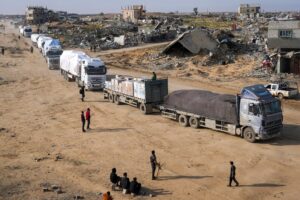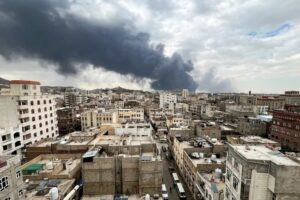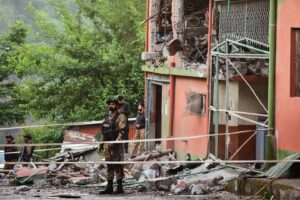
The National Interest Foundation Newsletter
Issue 285, May 9, 2025
Welcome to our NIF Newsletter. In this week’s edition, we look into how the Israeli plan to control aid delivery and expand the Gaza War has been rebuked as a clear violation of international law, examine Israel’s attacks on Yemen and the root cause of Israeli-Houthi tensions, and explore whether clashes between India and Pakistan could develop into full-scale war.
Editor: Bassam Tarbush
Israeli Plan to Control Aid Delivery and Expand the Gaza War is Rebuked as a Clear Violation of International Law

UN aid agencies and others have denounced Israel’s plan as a flagrant infringement on essential humanitarian principles like independence and impartiality. (Photo from AP)
United Nations (UN) relief agencies and other humanitarian organizations have strongly rebuked Israel’s plan to take control of aid distribution in Gaza, a proposal that was pushed through by the Israeli cabinet earlier this week in addition to one that would expand the military offensive and include the occupation of territory in the enclave. Aid groups have highlighted how the plan represents a blatant violation of international law for a variety of reasons. First, it contravenes the principles of international law stipulating that humanitarian aid and relief services are to be carried out by independent entities, not ones with political or military motives. If implemented, Israel’s plan would pave the way for it to further obstruct humanitarian relief services, and place arbitrary and opaque restrictions on who is able to provide and receive aid. Second, the design of the plan would compel many of the most vulnerable in Gaza – including those less mobile – to have to move in order to get assistance, and international law forbids this type of forcible displacement of people. Additionally, the private U.S. security contractors that Israel seeks to use as a part of its aid takeover plan are not considered eligible humanitarian partners for grants from major donors like the European Union (EU) – hence why the EU opposes any changes that would result in Israel seizing full control over this in Gaza as well.
On top of the array of aforementioned ways in which Israel’s plan violates international law, rights groups have also outlined the gravity of the ongoing humanitarian crisis in Gaza. For over two months since early March, Israel has imposed a full ban on the entry of humanitarian aid and supplies into the Gaza strip, including food, water, essential medical supplies and equipment, fuel, and material for shelters. As a result, critical humanitarian supplies have rapidly depleted or run out entirely, exacerbating already dire conditions. Medical workers have documented the troubling uptick in the number of people, particularly children, who have been admitted to healthcare facilities suffering from acute nutrition-related issues over the past two months – all directly correlated to the widening scarcity of humanitarian supplies. UNICEF and other UN agencies have noted the dramatic increase in cases of children with severe levels of malnutrition since March, which has seen an estimated 80% rise during this time period. In order to truly help alleviate the worsening humanitarian conditions in Gaza, UN officials are denouncing Israel’s plans and instead calling for an end to the imposed blockade so that neutral relief agencies can bring in the necessary supplies to address the crisis. Yet all the while, Israel is working to set up a new entity called the “Gaza Humanitarian Foundation” and registering it in Switzerland as a part of its propaganda efforts to try and “sell the idea” of its aid takeover – an action which observers highlight is merely aimed at distracting from its violations in Gaza and offering it the opportunity to further hinder actual established and reputable aid organizations. It was also revealed earlier this week that the Trump administration is pressuring international humanitarian organizations behind the scenes to cooperate with Israel’s plan, despite it being widely criticized. The Israeli government’s direct control over this process would allow it to manipulate the mechanisms for aid distribution, and as one commentator pointed out, institute a system of “aid denial” rather than one which guarantees fair dissemination to all in need.
Similarly to its heavily criticized aid distribution takeover, Israel’s plan to expand the Gaza War has elicited rebuke as well. The intensified military offensive consists of the intention to relocate millions of Gazan civilians – despite the fact that forcible displacement is a crime under international law. Israeli officials have suggested that it includes the “conquest” and military occupation of additional territory in the Gaza Strip, with Netanyahu continuing to promote the idea of expelling Palestinians from the enclave and looking for ways in which to do so. Expanded Israeli military operations in Gaza will lead to countless more civilians being killed, further destruction, and a deepening of humanitarian suffering there. Israel’s plan has been condemned internally, by the Hostage Families Forum – which represents the majority of relatives of those being held in Gaza – and some officials, both of whom contend that the Israeli government is acting against the will of most citizens who overwhelmingly favor a deal to secure the release of all remaining hostages over a dangerous prolonging of the conflict. The prospect of an intensified Israeli offensive has prompted serious international concern too. French, British, and UN officials, among others, have labeled the plan as unacceptable and in violation of international humanitarian law.
Even in the midst of all of the condemnation that it is garnering for its plan to control aid delivery and expand the Gaza War, Israel is also attempting to initiate a repressive crackdown on the work of humanitarian organizations that provide aid and monitor human rights violations. The Israeli government has put new regulations in place for these aid groups requiring them to submit detailed information, all aimed at giving officials the ability to disqualify them for merely shedding light on examples of Israel violating international law. Dozens of prominent humanitarian organizations signed a letter this week protesting the new rules and drawing attention to how they are based on purely politicized criteria that seeks to silence advocacy and suppress evidence of Israeli rights abuses and war crimes. Both this and Israel’s recent plan regarding the administering of aid are clear unlawful attempts to assert control over what should be impartial humanitarian operations free from the harmful influence of politically-motivated entities.
Israel’s Attacks on Yemen and the Root Cause of Israeli-Houthi Tensions

The Israeli strikes on Yemen targeted civilian infrastructure and facilities. (Photo from Reuters)
An Israeli attack on Yemen in recent days has ratcheted up the threat of potential further retaliations and escalations. Earlier this week, a Houthi missile fired towards Israel hit near the latter’s main airport outside of Lod, while Israel carried out a wave of bombings targeting the Sanaa International Airport, other civilian sites, and Yemen’s Hodeidah port. All of this comes in the midst of President Trump’s announcement that the United States would cease its bombing campaign against the Houthis in an Oman-mediated ceasefire deal. However, the Houthis have remarked that the recently reached agreement with the United States does not apply to their operations against Israel, and they have pledged to continue this and respond to Israeli attacks and aggression.
While Israel claims that the Sanaa International Airport is a hub for the Houthis to transfer weapons and receive supplies, analysts have disputed this and lament that Israel’s attacking of the airport and Yemen’s Hodeidah port will only hurt civilians by hindering the work of humanitarian agencies seeking to help alleviate conditions in the country. Both sites function as important means of getting lifesaving medical treatment and humanitarian supplies to those in desperate need. Observers have also been quick to point out that the root cause of the troubling Houthi-Israeli tensions is Israel’s destructive military offensive in Gaza. During the ceasefire there between January and March, the Houthis had halted their operations against Israel and only restarted them following Israel’s decision to enforce a total blockade on the besieged Gaza Strip and initiate a resumption of its hostilities. Due to this, many contend that effectively addressing the escalated tensions between Israel and the Houthis requires putting a permanent end to the hostilities in Gaza that are fueling the precarious circumstances throughout the region.
Thus, while the Trump administration might try to sell its ceasefire agreement with the Houthis as a notable diplomatic achievement, the Houthis’ comments in the aftermath of this regarding their intention to continue operations against Israel demonstrate that more is needed for a genuine quelling of the situation. Israel’s breaking of the Gaza ceasefire deal – whose first phase was implemented back in mid-January but did not progress to the agreed-upon second stage – and the United States’ failure to use its leverage over Israel in order to ensure that it upholds the agreement is ultimately what has led to the ongoing state of tensions and risk of further escalations between Israel and the Houthis in Yemen. While the recent U.S.-Houthi truce could reflect an acknowledgement from Trump regarding growing American public opposition to the prospect of U.S. entanglement in foreign wars, truly minimizing the risk of new developments that could drag the United States into an expanded conflict in the Middle East is contingent upon ending Israel’s destructive war in Gaza. In the absence of this, the threat will remain.
With respect to the U.S.-Houthi ceasefire agreement, it has been reported that news of the deal caught Israeli officials by surprise, as Tel Aviv was unaware of attempts aimed at reaching such an agreement. For issue experts, it is noteworthy that Israel only learned of the ceasefire news when President Trump announced it publicly during an Oval Office meeting with Canadian Prime Minister Mark Carney and that the Trump administration seems keen on fiercely pursuing nuclear talks with Iran in spite of Israel’s clear objections to both. They also took notice of the fact that President Trump’s announcement of the news failed to mention the ongoing situation between the Houthis and Israel, and that the American president merely remarked that “I’ll discuss that if something happens” when asked about it. All of this suggests that the Trump administration is willing to take actions that ignore Israel’s interests and demonstrates that the American president is growing increasingly frustrated with Netanyahu. The Houthis hit Israel today, and if the circumstances persist, it will be interesting to see how – if at all – the Trump administration reacts.
Could Clashes Between India and Pakistan Develop into Full-Scale War?

Cross-border strikes by the neighboring countries have raised fears of a potential wider conflict. (Photo from AP)
Recent military actions between India and Pakistan have elicited concern regarding the possibility of an all-out war. The inflaming of tensions and cross-border strikes by the neighboring countries have arisen in the aftermath of last month’s Pahalgam attack whereby 26 civilians were killed in an Indian-administered region of disputed Kashmir. India accused Pakistan of being behind the attack, a charge which Pakistan vehemently denies, leading to a standoff which eventually devolved into clashes between the two countries. Analysts have noted that the risks of further escalation and a spiraling of the situation are significant, especially considering the more centralized areas where India has chosen to carry out its strikes in Pakistan this time – a distinct difference from the 2019 India-Pakistan border skirmishes. Back then, India struck a single and remote location in Pakistan as opposed to its current ones which have hit more densely populated parts of Pakistan’s Punjab province – a place not targeted since 1971 – and its administered areas in Kashmir. As a result of this, issue experts argue that Pakistan’s leadership will feel that it possesses the right to respond to India in a fairly large manner. Still, a full-scale war is considered unlikely due to the high risks and consequences, however, the situation remains volatile as global actors urge both nations to exercise restraint and work to de-escalate through diplomacy.
Although flare-ups between India and Pakistan are not an abnormal occurrence, with recent episodes taking place in 2016 and 2019, India’s military strikes this time around have been deemed to be markedly more aggressive than the aforementioned instances. Several were carried out in Pakistan’s populous Punjab region, which had not been attacked by India since the two countries fought a full-scale war in 1971 that ultimately resulted in the establishment of Bangladesh as an independent nation. Shelling, the exchanging of fire, and drone attacks have been seen across both sides of the Line of Control (LoC) in disputed Kashmir, as well as areas along the India-Pakistan border. Some observers have suspected that India may feel that any strong criticism of its actions from the United States and other global leaders is unlikely, and therefore, it has license to be more aggressive than it otherwise would normally be. On the flip side, Pakistan is making a clear effort to portray India’s military actions as belligerent, and in doing so, seeking to convince the world that the strikes necessitate a defensive response while at the same time rallying the public in support of one.
In helping to explain why things transpired the way that they have, subject matter experts have drawn attention to factors seemingly influencing the actions of the Modi government in India. Following the late April Pahalgam attack, there has been a high level of pressure on Indian officials to forcefully initiate a military action against Pakistan. As one commentator stated, “it would have been unfathomable for India’s government not to respond militarily, given Modi’s self-projection as an administrator who is strong, confident, and decisive.” Furthermore, the Pahalgam attack had sparked a desire for retribution among the Indian public against those viewed as the enablers behind it – whether this is in fact accurate or not, it was certainly what many Indian government officials convinced a large segment of the population regarding who was responsible for the attack.
Adding to the seriousness of the circumstances surrounding the cross-border strikes between India and Pakistan is the fact that the two countries are among the world’s nuclear-weapon states, with both possessing a substantial number of nuclear warheads. The Stockholm International Peace Research Institute (SIPRI) – a think tank that conducts research and provides data on armaments and military expenditures – estimates that Pakistan and India each possess about 170 nuclear warheads. This component undoubtedly contributes to the international alarm regarding any spike in hostilities, as has manifested over the preceding weeks. Since the two countries declared themselves nuclear weapon states back in 1998, each has developed an arsenal that includes long-range missiles which have enough of a range to target the other. Additionally, India and Pakistan are believed to be two of the world’s five-largest arms importers, demonstrating the scope of their weapons stockpile, and thus the potential devastation of an expanded and wider-scale conflict between the two. In fact, India was the second-largest arms importer across the entire globe between 2020 and 2024 (behind only Ukraine), while Pakistan’s imports during the past decade have increased by a whopping 61 percent.
The current state of affairs has led many to describe it as the most serious crisis and expansive military clashes between the neighboring countries in decades, as there have been accounts of initiated attacks in India and Pakistan well beyond their disputed Kashmir border. The scale of the military exchanges and the level of rhetoric on both sides mean it will be challenging to diffuse hostilities, and with the back-and-forth escalations, the region finds itself at a junction where a misstep runs the risk of widening the conflict even further. Whether this happens or not, and to what extent, remains to be seen.
Enter the text or HTML code here
